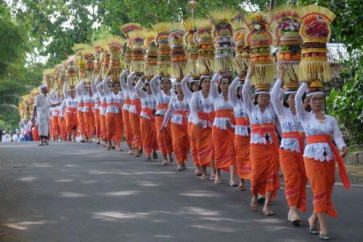James Ritchie: Unsung defender
James Ritchie: (JP/Severianus Endi)In spite of his Western face, sturdy physique and dominant Scottish blood, this Eurasian is a fluent Malaysian speaker
Change text size
Gift Premium Articles
to Anyone

J
span class="caption" style="width: 439px;">James Ritchie: (JP/Severianus Endi)In spite of his Western face, sturdy physique and dominant Scottish blood, this Eurasian is a fluent Malaysian speaker. He is James Ritchie, 62, a Malaysian who has interacted with people in various parts of Kalimantan for decades.
“In today’s flight, I met only 10 Malaysians from Kuching to Pontianak but there were about 30 Indonesians flying back from Kuching to Pontianak,” James told The Jakarta Post recently, describing the ever increasing ties between both nations.
“West Kalimantan is so near to Sarawak that interaction becomes better and better, not only for tourism and recreation but in Kuching also for hospital or medical care,” said James, who frequently spends his weekends in Pontianak, West Kalimantan.
The Pontianak-Kuching flight takes only 27 minutes and West Kalimantan’s borders with Sarawak, Malaysia, are relatively better arranged.
“Between Sarawak and East Kalimantan there are still too many forest areas. In West Kalimantan, you have five borders although two of them are not yet operational,” he added.
Born in Penang on June 26, 1950 of Scottish, Thai, Chinese and Malay descent, James Alexander Ritchie is the son of John George Ritchie, who was the first Malaysian commissioner of Sarawak from 1967 to 1970.
In 1969-1970 he found an outlet for his musical talent by working as a hotel singer. He began his journalistic career as a sports stringer for The Straits Times, Malacca, in 1971 and became a full-time journalist in 1972 in Kuala Lumpur. For 25 years from 1972, he was a journalist for The New Straits Times. His latest position was as executive director of New Sarawak Tribune in 2010-2011.
He has written 26 books and won 20 journalistic awards, including the Ang Lai Soon Gold Award, Shell Kenyalang Gold Award, AZAM Press Award and a consolation prize from the Esso National Environmental Awards from 1986 to 1997. He has also produced two documentaries depicting the life of a community living in a remote area of Sarawak.
James visited West Kalimantan for the first time in 1987. He entered through Lubok Antu in Sarawak, which shares a common border with Nanga Badau in Kapuas Hulu regency, West Kalimantan. At the time, village paths were still a dominant view of the region.
James began his adventure by going through forests and rural settlements by motorcycle taxi. In one particular village, he found local people having a celebration called gawai with a lot of richly adorned traditional boats.
Since then, he has been become further infatuated with western Borneo and maintains friendships with ethnic Dayak people in the interior. In Sarawak, many members of the Iban sub-ethnic group have kinship with West Kalimantan’s Iban community.
One day in 1993 — while working for The New Strait Times of Malaysia — he was surprised to read a story published by a magazine belonging to what he called Orang Puteh (White Westerners), about a very barbaric ethnic group, Punan Basap, in the Tarakan area in East Kalimantan.
His spirit of adventure prompted him to uncover the truth of the story. The Punan Basap people were said to be living in caves without clothing and eating raw meat as they were unable to make fire. This sensational account urged James to unveil the mystery of life that was seen as very odd in this modern era.
“I didn’t believe the story. How come they lived like that? I went to their village to see them,” said James. After trekking through village paths for days, he met a local evangelist who was prepared to take him to the Punan Basap community. He was also lucky to find an evangelist from Sarawak there.
The head of the village denied James’ entry due to his Western face, until he showed his passport certifying his Malaysian citizenship. The village head turned out to have heard the story and the community also felt embarrassed and prevented white-skinned people from entering their settlement.
He brought with him from Sarawak a photograph featuring around ten people, men and women, in a line wearing no clothes. James was also fortunate to see a man and a woman in the village that looked exactly like those in the picture.
“In the village I saw one man with long hair. I asked him, ‘do you speak Indonesian?’ He replied to my surprise, ‘yes, I am an Indonesian, of course I speak Indonesian’. So the story was bogus because they wrote these people didn’t speak Indonesian,” commented James.
Showing the photos, he asked why the people appeared to be unclothed. When he met them, they were all clad like normal citizens. The two explained they had once been visited by white-skinned men and asked to pose that way. They innocently complied with the request, only to find later that the picture was used for a story cornering their position.
“Orang Puteh wanted to tell the world that Punan Basap was savage and barbaric, so that there would be a reason to introduce them to a new religion, I think,” concluded James. “After I got back to my office, I wrote three articles about my journey and what I saw of the life of the Punan Basap people. I revealed the falsehood of the previous story,” added James.
No complaints followed the rebuttal of the barbaric existence. He jokingly said if only the Indonesian government had read his articles, he could have received an award for exposing the reality of community life in an interior part of the country.
James also gained popularity for saving an orangutan. In 1989, in the Batang Aik area, Lubok Antu district, Sarawak, while he was accompanying an Australia peer wishing to observe the habitat of the primate, he found a 3-year-old orangutan in a hunter’s cage.
James managed to persuade the hunter to give up the orangutan after being told he had breached the relevant law and might go to jail. He took care of the ailing orangutan before being finally picked up by forestry officers and sent to the Semenggok Rehabilitation Center, 24 kilometers from Kuching.
“The orangutan was called Ritchie, after me,” James recalled laughingly. One night, a large female orangutan took Ritchie out of the center to a nearby forest. Their mating contributed seven new orangutans to Semenggok, taking the centers total to 30.









